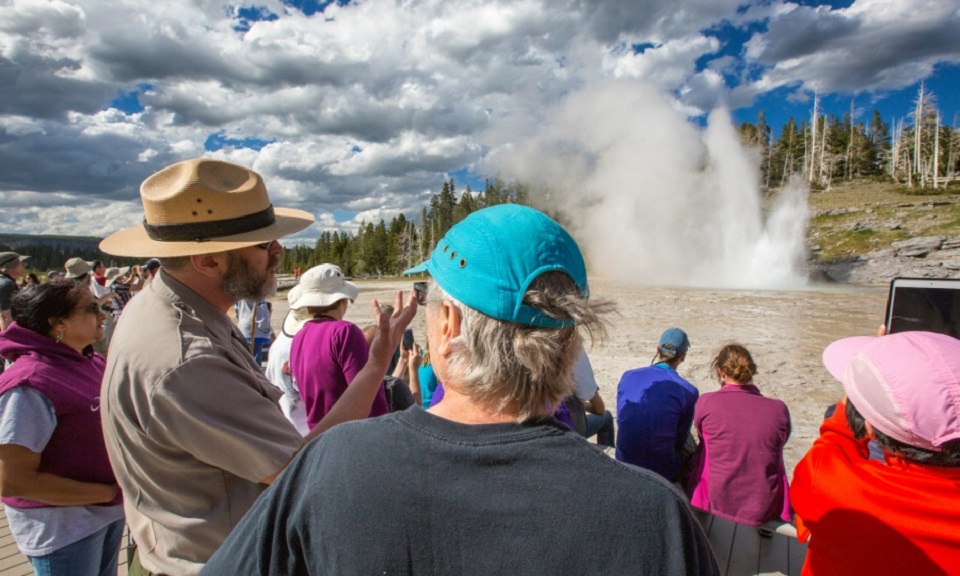News Release

NPS / Neal Herbert
News Release Date: April 25, 2018
Contact: NPS Office of Communications
(Press release originally distribted by the Department of the Interior Press Office)
Report Finds Parks Support 306,000 jobs Mostly in Hotels, Restaurants, Transportation, Recreation
WASHINGTON – As the nation celebrates National Park Week, U.S. Secretary of the Interior Ryan Zinke today announced that visitor spending in communities near national parks in 2017 resulted in a $35.8 billion benefit to the nation’s economy--a nearly $1 billion increase from 2016-- and supported 306,000 jobs.
According the annual National Park Service report, 2017 National Park Visitor Spending Effects, more than 330 million visitors in 2017 spent $18.2 billion in the communities near national parks. Of the 306,000 jobs supported by that spending, more than 255,000 were in those same communities that lie within 60 miles of a park.
“This report illustrates the incredible economic value of our national parks, and further shows the value in President Trump's plan to rebuild park infrastructure,” Zinke said. “National parks provide us a gateway to the outdoors, family recreation opportunities, and connect us to our history and heritage, and they are extremely vital to local economies all across the nation. Parks provide jobs and fuel the outdoor recreation and tourism economy. But as parks remain a popular destination for American families, we must continue to address deferred maintenance and infrastructure needs to ensure parks remain world-class destinations. One of the ways the President and I are doing this is by partnering with Congress on a bipartisan bill to address the maintenance backlog.”
“Parks are priceless not only for their intrinsic natural beauty and historical significance, but also for the economic benefits they provide to communities across the country,” said Will Shafroth, President and CEO of the National Park Foundation. “The investments we make in our national parks protect cherished places while promoting community and economic development.”
Visitor spending varied across the National Park System, from big parks like Yellowstone National Park which attracted 4.1 million people and supported more than 7,350 jobs, to smaller parks like Hubbell Trading Post National Historic Site that attracted more than 45,000 visitors and supported 43 jobs.
The lodging sector received the highest direct contributions with $5.5 billion in economic output to local gateway economies and 49,000 jobs. The restaurants sector received the next greatest direct contributions with $3.7 billion in economic output to local gateway economies and 60,500 jobs.
According to the 2017 report, most park visitor spending was for lodging/camping (32.9 percent) followed by food and beverages (27.5 percent), gas and oil (12.1 percent), souvenirs and other expenses (10.1 percent), admissions and fees (10.0 percent), and local transportation (7.5 percent).
“National parks connect us with nature and help tell America’s story,” said Dan Smith, Deputy Director of the National Park Service. “They are also a vital part of our nation’s economy, drawing hundreds of millions of visitors every year who fill hotels and restaurants, hire outfitters and rely on other local businesses that help drive a vibrant tourism and outdoor recreation industry.”
“National parks are proven economic engines for local communities and states,” said Marcia Argust, who directs The Pew Charitable Trusts’ project on restoring national parks. “Ensuring that our park sites are safe, accessible, and preserved for future generations is a smart and necessary investment.”
The peer-reviewed economics report was prepared by economists Catherine Cullinane Thomas and Egan Cornachione of the U.S. Geological Survey and Lynne Koontz of the National Park Service. It includes information by parks and by states on visitor spending, the number of jobs supported by visitor spending and other statistics.
Report authors also produce an interactive tool that enables users to explore visitor spending, jobs, labor income, value added, and output effects by sector for national, state, and local economies. Users can also view year-by-year trend data.
National Park visitation grew by 7.7 percent from 2015 to 2017 which included the 2016 centennial of the National Park Service and the successful Find Your Park campaign.
For more state-by-state information about national parks and how the National Park Service is working with communities, go to http://www.nps.gov/[statename], for example: http://www.nps.gov/virginia.
National Park Visitor Spending Contributions to the U.S. Economy 2012-17
|
|
Visitation |
Visitor Spending |
Jobs Supported |
Local Jobs |
Total Output |
|
2012 |
282,765,682 |
$14.7 billion |
242,712 |
201,040 |
$26.8 billion |
|
2013 |
273,630,895 |
$14.6 billion |
237,599 |
197,343 |
$26.5 billion |
|
2014 |
292,800,082 |
$15.7 billion |
276,960 |
235,600 |
$29.7 billion |
|
2015 |
307,247,252 |
$16.9 billion |
295,339 |
252,030 |
$32 billion |
|
2016 |
330,971,689 |
$18.4 billion |
318,000 |
271,544 |
$34.9 billion |
|
2017 |
330,882,751 |
$18.2 billion |
306,000 |
255,900 |
$35.8 billion |
About the National Park Service. More than 20,000 National Park Service employees care for America's 417 national parks and work with communities across the nation to help preserve local history and create close-to-home recreational opportunities. Visit us at www.nps.gov, on Facebook www.facebook.com/nationalparkservice, Twitter www.twitter.com/natlparkservice, and YouTube www.youtube.com/nationalparkservice.
Last updated: April 25, 2018
